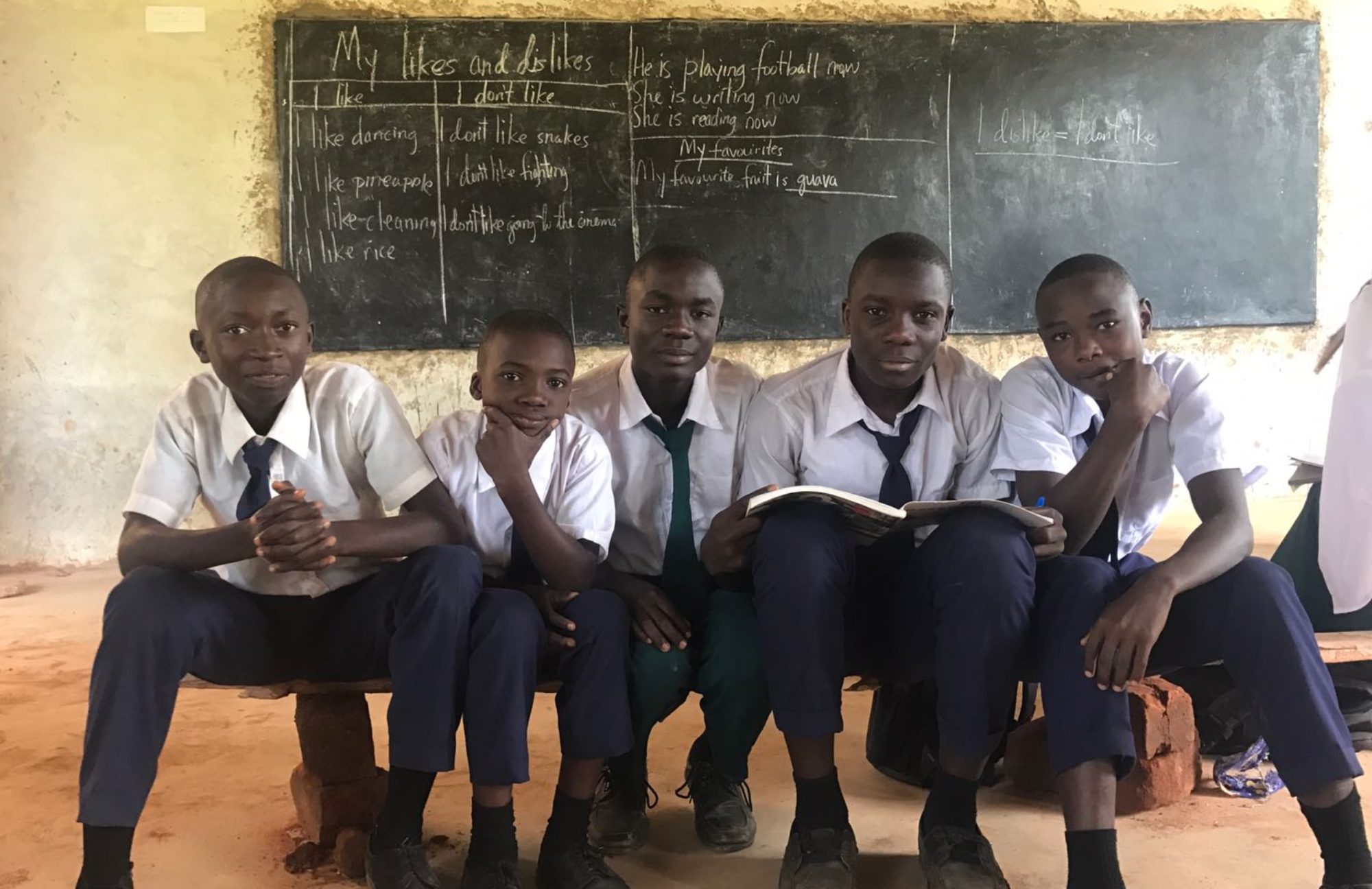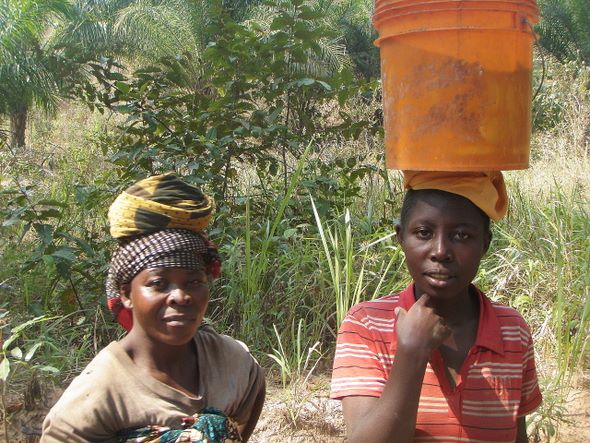Which means: I’m so tired, but now I can carry stones (‘to the head’, as they say). If I had typed up this blog yesterday after working with the villagers in Mgaraganza at the school site, the title might have read ‘Eff That!’ And ‘That’ would have been a reference to the work that we did – which was ridiculously difficult and in my opinion just plain ridiculous. But let me back up a bit…
The day before I worked side by side with the villagers, we had a meeting in the town with the council. As I mentioned, there were about 15 in attendance – 4 women, 11 men, one infant, one toddler and one pre-schooler (moms always come with kids in tow which is why I think they are often discouraged from participation in leadership positions; I was happy to see them this year. Last year there was one woman, this year, seeing these four – including Ashahadu’s wife – was inspiring).
In our meeting, Lucas simply recounted our trip to Kigoma the day before and the need for this council to step in and get to business with the official matters that I can’t (nor should I) be responsible for, such as acquiring the building permit, meeting with the land engineer to approve the building site, etc. I know full well that this is business that should have been taken care of prior to my arrival with the funding; however, as the request fell into my lap days before I left last year, I had no time to investigate and prod Lucas throughout the year to get x, y, and z done before my arrival. The village council probably could have done so – but again, without knowing what nudges to send Lucas into the village with – there was no way to get the ball rolling…. One more lesson learned – I’m merely a linguist for cryin’ out loud! haha
Regardless, I’m happy with how things are going now – the ball is rolling. I was feeling like Atlas to this point and as Atlas, I shrugged and now we’ve got a great project unfolding daily. So, in our meeting one woman piped up about the village contribution to the project. They will donate the stones, sand and bricks when the time comes – but she wanted to propose an exchange for the labor. Labor here pays 3,500Tsh a day (that’s about $2) but she would settle for 1,500Tsh ($1) a day because the labor is so difficult (carrying sand and stones on the head). In that moment, my response was that this was absolutely a village decision. I said that I had done my part to fundraise and I fell short of my goal for this year by just under half. (I didn’t tell them how much I raised, but while I wanted to raise $20,000USD, I came over with just over $10,000USD, which is actually awesome – but not quite the target number.) I emphasized that they could choose the best way to spend the money. Every penny they spend on labor will be less for the materials and therefore less construction ultimately for the amount Project Wezesha can give at this time. “Please know, this is not my project. This is your project and you as a community council should make this decision without me.”
Another man spoke to say he ‘supports my vision’ and agrees that they will donate the labor. I smiled and said they could vote and see what would be best for the group. The woman then spoke again to say that she was so grateful for Project Wezesha and the donations of all the people back home (I showed them the long long list of individuals who had given varying amounts of money toward the project so they would truly understand it’s not coming from me, but from all of you!). The woman went on to say she has three young children in primary school and she knows that this is their future. She is happy to work for the school. (I had to bite my cheek a few times in this meeting to avoid crying under the weight of the significance this project carries for the village. Seriously – THANK YOU so much to everyone who made this possible.)
I told them I would return early the next day to work with them. This is where my ‘Eff That’ sentiment comes in. The site had been partially cleared for construction prior to my arrival. The site is just as beautiful as I remember – atop a hill with views of Gombe National Forest in one direction and every possible valley and hill in all other directions. The initial work that we are doing now is the preparation for building. Isaya, the builder, will be coming early next week to start laying the foundation. The foundation is comprised of stones (large stones), sand and concrete. The villagers prep work consists of carrying the sand and the stones to the building site. This is where I join them – carrying stones and sand ‘to the head’ (This is how Lucas says it and I like it).
The men go in one direction from the building site to break up large boulders into stones that are reasonably sized to carry on the head. The distance they walk from the site of the stones and back to where the piles are being made is about 50 meters… not too bad. About 20 men showed up to work the first day I joined them. Each can carry one large stone or two medium/small stones. There is no transport for the stones (wheelbarrow) and there is no road that leads up to the site which would allow the use of trucks (and actually trucks cost too much anyway – this is a remote village with no vehicles, no real roads, just large paths and one or two wider dirt thoroughfares for walking and biking). The stones have to be broken with a pick axe. When I arrived, they told me their axe had broken – it was still partially functional, but I’ll be shopping for a new axe in the morning. When they told me about the axe, showed me the broken part and said work was difficult now, I told them that I would buy a new one and hand it over when the chief comes to Kigoma for our meeting Monday morning. They all started clapping.
The women walk in another direction down a hill and toward an old river bed where they fill plastic painter’s buckets with sand. After carrying two stones with the men, Lucas told me a woman had an extra bucket for me and I was to help the women. The distance from the sand pick up site to the school site is about 200 meters… at least. I went with Jane, Ashahadu’s wife, for the first collection. There were about 8 women working as well as one grandpa. Also, that morning I recruited (they offered to help the day before) Hindu, Dibeit, Saidi and Musa – the kids from Kiganza.
The sand buckets weigh a ton! The women roll up a scrap of kanga (the colorful fabric they wrap around their waists) and place it on their heads to soften the load a bit. Jane gave me a piece for my head. I couldn’t get the bucket on my head without help – it’s that heavy! Once it was on my head, we walked single file up the single track trail back up the hill to add to the growing pile.
We only made about five trips before they were calling it a day. It was only 11am! I can’t say I was unhappy about quitting. My neck – not strong like theirs from a lifetime of carrying ‘to the head’ – was tired. I wondered if I could do damage by jumping in like this, but I felt fine the day after. I could never carry the sand without balancing the bucket with my hands. These rockstar women not only carried the sand without the help of their hands for support, but in the case of three women they did so with babies on their backs. I told Lucas they should have one woman or even a ‘bibi’ (grandma) babysit while they worked. He replied with a laugh (and his all too familiar response to many of my observations or comments) “Rai, this is African peoples. This is Africa.” haha – I adore my partner!!
After a few hours of work, the whole team was ready to head back to the village center to congregate in the tea houses (men) or prepare the lunch (women). For the rest of the day – would they work? No. I don’t get it, but I can’t exactly expect much more productivity when they are all working for free and working hard!
Many things about the way this has to be done puzzled me. It seemed so slow and tedious – one bucket or stone at a time, three hours a day, 30 hands on deck. It seemed to me that it would take years to get enough for the foundation. Lucas said as Isaya’s team begins the work, the villagers will continue to come with sand and stones. Pole Pole (Slowly, Slowly). My frustration that day came in part from the pain of hefting the sand on my head uphill and in part to the sight of the work being done so inefficiently and slowly. But, it’ll happen and I’m sure I’ll be pleasantly surprised by how well.
Before we all retired back to the village, one elder man – the grandpa helping the women work – pulled out his whistle. Everyone gathered around clapping as Grandpa danced a ‘happy’ dance to celebrate the work done and the chai to come. We all laughed and clapped when he finished. Then everyone wandered off in various directions into the trees, back to their homes or the village center (don’t blink – you might miss it.)
As the day was young and we were all tired, I decided to treat Lucas and the kids (Hindu, Musa, Saidi and Dibeit) to a thank you meal. The kids seldom get to go into Kigoma town from the village. We walked about an hour back to Kiganza where we piled into a tightly packed dala dala and headed straight to the ‘New Modern Café’ to share three plates of fish and rice. After filling our bellies – we walked another distance to the lake – to a part of Lake Tanganyika where the water is never more than 4 feet deep for quite a distance. The boys dropped to their shorts and Hindu and I made our way out fully clothed. Some other ‘watoto’ joined us and we all splashed around and laughed until it was time to get the kids home. Lucas saw them off at the dala dala station in town and I went back to my hotel where I slept 11 hours!

